|
|
 |
|
 |
| |
Publisher:
Chairman Ching-Fuh Lin Editors:
Professor I-Chun Cheng, Ms. Hsiao-wen Lin September 10,
2011 |
| |
|
 |
|
Congratulations! GIPO Professor Way-Seen Wang receives the title of “MXIC Chair Professor”.
|
|
 |
|
 |
|
| |
|
 |
|
April “Photonics Forum” Highlights
(Compiled by Li-Chi Yao) |
|
|
April 15th (Friday), 2011, 3:30 pm |
|
Speaker: |
Mr. Huang-Xiong Huang
(The founder of Taiwan Research Fund and a 4th-session member of the Control Yuan) |
|
Topic: |
Taiwan Spirit: the pursuance of
Jiang, Weishui’s (Taiwan's Sun
Yat-Sen) Generation |
| |
Mr. Huang-Xiong Huang visited GIPO
on April 15th (Fri.) and
delivered a speech on "Taiwan
Spirit: the pursuance of Jiang, Weishui’s (Taiwan's Sun Yat-Sen)
Generation " at Auditorium 101,
Barry Lam Hall. Mr. Huang’s speech
was marvelous. GIPO professors and
students participated in the event
with enthusiasm and benefited
greatly from the experience.
|
| |
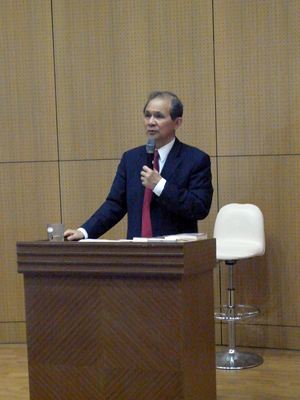 |
|
Mr. Huang-Xiong
Huang |
|
|
|
April 22nd (Friday),
2011, 3:30 pm |
|
Speaker: |
Professor Yuen-Ron Shen
(Professor
of Graduate School, University of
California, Berkeley) |
|
Topic: |
Surface Nonlinear Optics |
| |
Professor Yuen-Ron Shen visited GIPO
on April 22nd (Fri.) and
delivered a speech on "Surface
Nonlinear Optics" at Auditorium 101,
Barry Lam Hall. GIPO professors and
students participated with
enthusiasm, and all participants
benefited greatly from the speech.
|
| |
 |
|
Professor
Yuen-Ron Shen |
|
|
May “Photonics Forum” Highlights
(Compiled by Li-Chi Yao) |
|
Time: |
May 6th (Friday), 2011,
3:30 pm |
|
Speaker: |
Mr. Jimmy Chang
(master of psychology, NTU; clinical
psychologist - civil service senior
examination passed) |
|
Topic: |
From the Stress of Life to the
Vitality for Life
|
| |
Jimmy Chang, clinical psychologist,
visited GIPO on May 6th
(Fri.) and delivered a speech on
“From the Stress of Life to the
Vitality for Life" at Auditorium
101, Barry Lam Hall. His speech was
marvelous and comprehensive in every
respect. He nicely interacted with
GIPO professors and students as he
spoke. All participants attended
with enthusiasm and benefited
greatly from the experience. |
| |
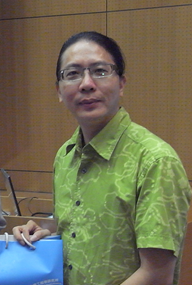 |
|
Mr. Jimmy
Chang, clinical psychologist |
|
|
Time: |
May 13th (Friday), 2011,
3:30 pm |
|
Speaker: |
Dr. Ming-Fong Chen
(Superintendent,
National Taiwan University Hospital)
|
|
Topic: |
The Integration of Medical Care and
Other Professions - Prospects for
Development of the Medical Industry
and the Application of Technologies
|
| |
Superintendent Ming-Fong Chen
visited GIPO on May 13th
(Fri.) and delivered a speech on
"The Integration of Medical Care and
Other Professions - Prospects for
Development of the Medical Industry
and the Application of Technologies"
at Auditorium 101, Barry Lam Hall.
GIPO professors and students
attended with enthusiasm and had
benefited greatly from the speech.
|
| |
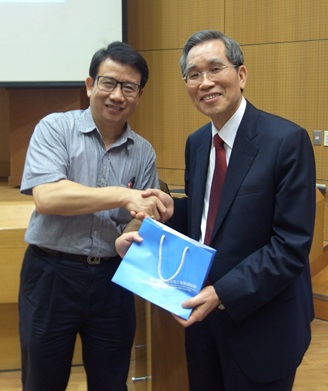 |
|
Dr. Ming-Fong
Chen, Superintendent, National
Taiwan University Hospital
(right) |
|
|
June “Photonics Forum” Highlights
(Compiled by Li-Chi Yao) |
|
|
June 3rd (Friday), 2011,
3:30 pm |
|
Speaker: |
Dr. Carson Hsieh (Vice-president of
the R&D center and CTO at Epistar)
|
|
Topic: |
The Development of
Solid-State Lighting Technology
|
|
Dr. Carson Hsieh visited GIPO on
June 3rd (Fri.), and
delivered a speech on "The
Development of Solid-State Lighting
Technology" at Auditorium 101, Barry
Lam Hall. His speech was fascinating
and comprehensive in every respect.
Dr. Hsieh also interacted nicely
with the audience throughout his
speech. GIPO professors and students
attended with enthusiasm and learned
a lot from the speech. |
| |
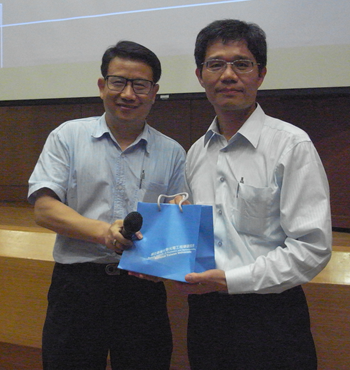 |
|
Dr. Carson
Hsieh (right) |
|
~ GIPO Students Association Basketball Tournament Highlights
~
(Time: April 10th, 2011; Location: NTU Sports Center)
Compiled by: Meng-Chien Lu, President, GIPO Students’ Association
The GIPO Students Association and GIPO office jointly organized the 1st GIPO Basketball Tournament on April 10th, 2011. Students registered for the game with enthusiasm. There were 12 teams registered for the five-on-five match, 22 teams registered for the three-on-three bullfight match and 60 students registered for the three-pointer match.
The five-on-five match teams were
organized according to laboratories.
Every team member tried his/her best to
win the first prize for his/her
laboratory. Even Professor Jr-Hau He
participated in the event, representing
laboratory 301, EE Building II. We
sincerely believed that he indeed
deserved a round of applause. After a
fierce battle, the team of laboratory
531, EE Building II, won the
championship.
In the three-on-three match, the student
teams were unexpectedly defeated by the
GIPO office's family team, which, to our
surprise, actually made it to the
finals. Fortunately, the Yang Yao-Yang
team, one of our student teams, scored a
buzzer beater at the last possible
second, securing a key point, and
defeating the GIPO office's family team
by just one point. They won the
championship and helped us young
students retain a bit of our dignity.
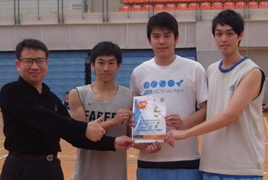 |
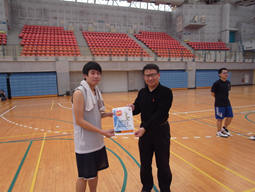 |
The
chairman
commended
the Yang
Yao-Yang
team -
the
three-on-three
match
champion.
|
The
chairman
commended
Da-Wei
Liu -
the
three-pointer
champion.
|
The situation on the three-pointer
battlefield was intense as well.
Players' scores were extremely close.
Originally, chairman Ching-Fuh Lin would
have liked to take part in the match as
well. However, because the leather shoes
he wore were prohibited on the court, he
was unable to play. In the end, Da-Wei
Liu, a student of laboratory 305B, EE
Building II, stood out above the rest
and won the three-pointer championship.
We would like to especially thank the
chairman for his kind attention to this
event. The tournament was on his mind
even when he was abroad, and he came
directly from the airport to join us
when he returned to Taiwan. He had also
helped commend the winners of the
three-on-three bullfight and the
three-pointer matches. We were all
deeply touched by his enthusiasm and
congeniality.
We believed that the one-day-long
activity had increased the camaraderie
among GIPO students. Almost everyone in
laboratory 312, Barry Lam Hall, came out
to watch the game and encouraged the
players. At the end of this event, all
the participants left with happy
memories which stood out from the
monotonous research work and studies.
 |
 |
A group
photo of
laboratory
531, EE
Building
II -
the
five-on-five
match
champions.
|
Lots of
GIPO
students
registered
for the
event,
which
made the
competition
extraordinarily
fierce.
|
|
 |
|
 |
|
| |
|
 |
|
Surface Plasmons and Its
Application in Plasmonic
Thermal Emitter (PTE)
and Solar Cell
Professor Si-Chen
Lee
Graduate Institute of Photonics and
Optoelectronics, National Taiwan
University
-
“Localized shape
resonance on silver film
perforated by H-shaped
and more complex shaped
hole arrays”,
Hao-Fu Huang, Yu-Wei
Jiang, Hung-hsin Chen,
Yi-Ting Wu, Yi-Tsung
Chang, Fang-Tzu Chuang,
and Si-Chen
Lee,
Optics express, Vol. 19,
Iss. 6, pp. 5225–5231
(2011).
 |
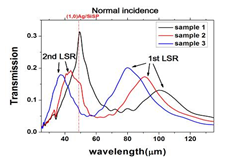 |
| (a) |
(b) |
|
Fig. 1 (a) Top view and structure parameter of samples 1 to 3. (b) Zero-order transmission spectra at normal incidence of samples 1, 2, 3. The vertical red dash line represents the theoretical position of degenerated (1, 0) Ag/Si mode.
|
-
“Wavelength
Selective Plasmonic
Thermal Emitter by
Polarization Utilizing
Fabry-Pèrot Type
Resonances”,
Pei-En Chang, Yu-Wei
Jiang, Hung-Hsin Chen,
Yi-Tsung Chang, Yi-Ting
Wu, Lawrence Tzuang,
Yi-Han Ye and Si-Chen
Lee,
Appl. Phys. Lett., 98,
073111 (2011).
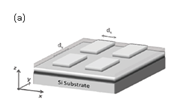 |
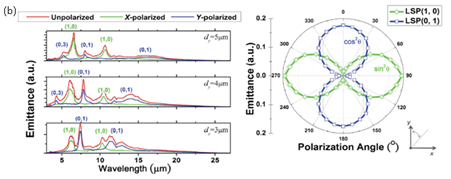 |
| (a) |
(b) |
|
Fig. 2 The schematic view of (a) a MIM PTE with rectangular metallic patch arrays as top layer. (b) Emittance spectra of three samples with all dx equal to 2 mm and dy = 3, 4 and 5 mm, respectively. The LSP (1, 0) and (0, 1) modes are at wavelength of about 6 mm and 8 mm, respectively. The green dotted curve is a fit of LSP (0, 1) to a Sin2θ dependence, while the blue fit curve of LSP (1, 0) to a Cos2θ dependence.
|
-
“Hydrogenated
Amorphous Silicon Solar
Cell on Glass Substrate
pattered by Hexagonal
Nano-Cylinder Array”,
Wei-Chen Tu, Yi-Tsung
Chang, Chieh-Hung Yang,
Dan-Ju Yeh, Chung-I Ho
and Si-Chen
Lee,
Appl. Phys. Lett., 97,
193109 (2010).
Modal
Characteristics of Antiresonant
Reflecting Pipe Waveguides for Terahertz
Waveguiding
Professor Hung-chun Chang
Graduate Institute of Photonics and
Optoelectronics, National Taiwan
University
The
pipe waveguide is promising for
terahertz (THz) waveguiding owing to its
low-loss feature and simple structure.
In this work, modal characteristics of
the leaky core modes of the pipe
waveguide are investigated in the THz
range. Utilizing the finite-difference
frequency-domain (FDFD) mode solver,
modal indices and attenuation constants
of the core modes which are frequency
dependent are calculated for different
core diameters, cladding thicknesses,
and cladding refractive indices. It is
found that at certain frequencies no
core modes can exist. Comparing these
frequencies with the resonant
frequencies of the cladding reveals that
the guiding mechanism of the core modes
is that of the antiresonant reflecting
guiding. Calculated results also suggest
that, to have a low-loss and
high-bandwidth pipe waveguide, large
core diameter, thin cladding thickness,
and low refractive index are desired.
The effect of material absorption is
also examined, which shows that the
attenuation constant magnitude will be
increased and the increment is more
significant at higher frequencies.
Moreover, modal patterns are shown for
the fundamental mode and the higher
order modes, including modal intensity
distributions and electric field vector
distributions. It is observed that modal
patterns of the core modes of the pipe
waveguide resemble those of the guided
modes of the step-index fiber. From the
spectrum of the attenuation constant, it
shows that the fundamental mode (HE11-like)
has the smallest attenuation constant
and is the dominant mode for the pipe
waveguide investigated. Using
time-domain spectroscopy to measure the
transmission spectra of PMMA pipes in
collaboration with Prof. Chi-Kuang Sun,
guiding mechanism of the pipe waveguides
was experimentally confirmed to be that
of antiresonant reflecting guiding. (Optics
Express, vol. 18, no. 1, pp.
309–322, 22 January 2010.)
|
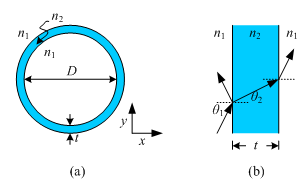
|
| Fig. 1. (a) Cross-section of the pipe waveguide, where n1 = 1 (air). (b) The cladding can be viewed as a Fabry-Perot etalon. |
|
|

|
| Fig. 2. (a) Modal indices and (b) attenuation constants of the fundamental core mode of the pipe waveguide for D = 7 mm and 9 mm. |
|
|
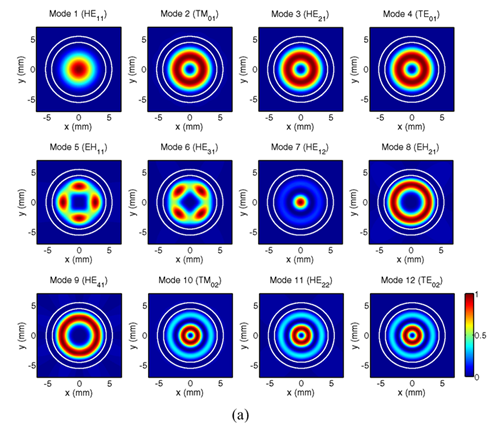
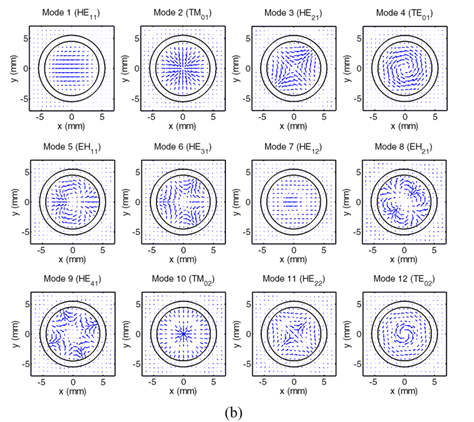
|
| Fig. 3. (a) Modal intensity distributions and (b) electric field vector distributions of the first twelve lowest modes of the pipe waveguide at 380GHz. |
|
Localized Surface
Plasmon Resonance
Behaviors of Au
Nanorings Monitored with
Optical Coherence
Tomography
Professor C.
C. (Chih-Chung) Yang's Laboratory
Graduate Institute of Photonics and
Optoelectronics, National Taiwan
University
Preparation of a high-concentration Au
nanoring (NRI) water solution and its
applications to the enhancement of image
contrast in optical coherence tomography
(OCT) and the generation of photothermal
effect in a bio-sample through localized
surface plasmon (LSP) resonance are
demonstrated. Au NRIs are first
fabricated on a sapphire substrate with
colloidal lithography and secondary
sputtering of Au, and then transferred
into water solution through a liftoff
process. By controlling the NRI
geometry, the LSP dipole resonance
wavelength in tissue can cover the
spectral range of 1300 nm for OCT
scanning of deep tissue penetration. The
extinction cross sections of the
fabricated Au NRIs in water are
estimated to give the levels of 10-10-10-9 cm2 near
their LSP resonance wavelengths. The
fabricated Au NRIs are then delivered
into pig adipose samples for OCT
scanning. It is observed that when
resonant Au NRIs are delivered into such
a sample, LSP resonance-induced Au NRI
absorption results in a photothermal
effect, making the opaque pig adipose
cells transparent. Also, the delivered
Au NRIs in the intercellular substance
enhance the image contrast of OCT
scanning through LSP resonance-enhanced
scattering. By continuously OCT scanning
a sample, both photothermal and image
contrast enhancement effects are
observed. However, by continually
scanning a sample with a low scan
frequency, only the image contrast
enhancement effect is observed. Figure 1
shows the SEM image of an Au NRI. Figure
2 shows the extinction spectra of two
NRI samples (A and B) obtained through
transmission measurement. The major peak
of each curve corresponds to the LSP
dipole resonance. Figure 3 shows the OCT
scanning image of a pig adipose sample
with delivered Au NRIs. The adipose
cells have become transparent. Figure 4
shows the lateral line-scan profiles of
the OCT images of the heated pig adipose
samples with and without Au NRIs.
Enhanced scattering through LSP
resonance of Au NRIs can be seen.
|

|
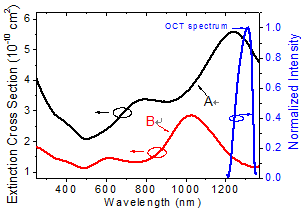 |
|
Fig. 1
SEM
image of
an Au
NRI. |
Fig. 2
Extinction
spectra
of Au
NRIs
(samples
A and
B). |
|
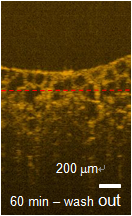
|
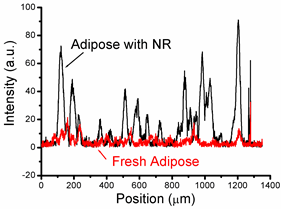 |
|
Fig. 3
OCT
image of
a pig
adipose
sample
with Au
NRIs. |
Fig. 4
Lateral
line-scan
profiles
of the
OCT
images
of the
heated
pig
adipose
samples
with and
without
Au NRIs. |
Numerical
Synthesis of Metallic Nanostructures for
Enhancing the Emission of a Dipole
through Surface Plasmon Coupling
Professor Yean-Woei
Kiang's Laboratory
Graduate Institute of Photonics and
Optoelectronics, National Taiwan
University
In
this study, we numerically synthesize a
two-dimensional metallic nanostructure
consisting of a Au half-space and two
separate Ag elliptical cylinders by the
simulated annealing (SA) method. The
simulated nanostructure is so designed
that the surface plasmon polariton (SPP)
and the localized surface plasmon (LSP)
are simultaneously excited at their
common resonant wavelength (535 nm),
leading to the enhancement of emission
of a nearby dipole source. This
enhancement effect is more significant
than that of the case where only one of
SPP and LSP is excited. In numerically
synthesizing a metallic nanostructure,
we try to maximize both the downward
emission (in the direction away from the
metallic structure) and the emission
efficiency. A cost function is defined
as some combination of the downward
emission and the emission efficiency. We
adjust the simulated structure by SA to
minimize the cost function at a
designated resonant wavelength, and
calculate and analyze the spectra of
downward emission and emission
efficiency for the optimal structure.
Other structures are also investigated
for comparison. From numerical
simulations, it is demonstrated that the
enhancement of dipole emission is better
for optimization at wavelength 535 nm
than at other wavelengths. Note that the
downward emission and the emission
efficiency can reach maxima almost
simultaneously when the SPP and the LSP
couple effectively at a common resonant
wavelength. This implies that the
lighting efficiency of green
light-emitting diodes (LEDs) can be
increased by the coupling effect at a
common resonant wavelength of SPP and
LSP.
|
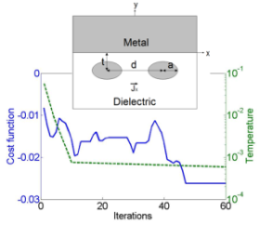
|
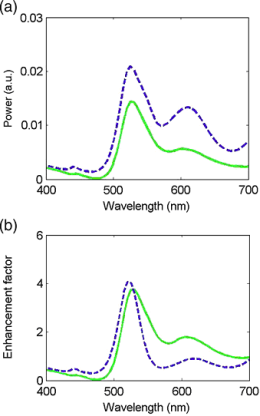 |
|
Fig. 1
Variation
of cost
function
in the
iteration
process.
The
solid
curve
represents
the cost
function
and the
dashed
curve
represents
the
chosen
temperature
distribution
used in
the SA
process.
The
synthetic
metallic
nanostructure
is shown
schematically
in the
insert.
An
x-oriented
dipole,
denoted
by an
arrow
and
labeled
by Jx,
is
located
at (x, y)
= (0, -h).
The
metal-dielectric
flat
interface
is at y =
0. |
Fig. 2
Spectra
of (a)
total
emission
(dashed
curve)
and
downward
emission
(solid
curve),
and (b)
enhancement
factor
of total
emission
(dashed
curve)
and
downward
emission
(solid
curve)
for
structure
A
(structure
parameters: a =
12 nm, d =
60 nm, t =
10 nm, h =
21 nm).
|
X-ray absorption fine
structure of InAsPSb
grown by gas-source
molecular-beam epitaxy
Professor Hao-Hsiung
Lin's Laboratory
Graduate Institute of Photonics and
Optoelectronics, National Taiwan
University
We have investigated
the atomic structure of InAsPSb, a
mid-infrared alloy consisting of
binaries with highly mismatch bond
lengths, using P K-edge and In K-edge
extended X-ray absorption fine structure
(EXAFS). The alloy with wide composition
range, grown by gas-source
molecular-beam epitaxy, were measured,
in collaboration with Prof. Zhe-Chuan
Feng, at National Synchrotron Radiation
Research Center. The InP bond length
determined from the P K-edge EXAFS,
shown in Fig. 1, is virtually
independent of alloy composition and
lattice constant, which is in conflict
with the virtual crystal approximation
and Vegard’s law and is very close to
Pauling’s model. The In K-edge EXAFS,
consisting of signals from InP, InAs,
and InSb bonds, is shown in Fig. 2. For
the samples with low As composition, two
separate peaks representing InP and InSb
bonds are evident. When the As
composition increases, the peaks
gradually merge into the rising InAs
signal. We used a model based on valence
force field (VFF) theory to fit the
EXAFS. The result shows that with the
increase of As mole fraction, the
dominant In-centered basic unit cell in
the alloys changes from cell with 2 P
and 2 Sb to cell with 4 As and finally
to cell with 2 As, 1 P, and 1 Sb. VFF
calculation indicates that cell with 2 P
and 2 Sb has higher bond distortion
energy than the other two cells, which
explains the immiscibility behavior we
observed in previous studies.
|

|
 |
|
Fig. 1 Fourier
transformed
P K-edge
EXAFS
signal
of the
InAsPSb.
The InP
bond
length
of the
samples
is
virtually
fixed. |
Fig. 2 Fourier
transformed
In
K-edge
EXAFS
signal
of the
InAsPSb. |
|
|
|
 |
|
 |
|
| |
|
|
 |
|
 |
|
|
|